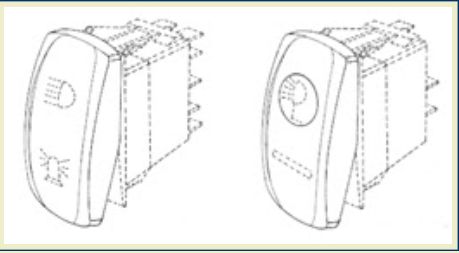The Board affirmed refusals to register the two product configuration marks shown below (claimed design shown in solid lines), for ""actuators for rocker switches," on the ground that Applicant Carling Technologies failed to prove that the designs had acquired distinctiveness under Section 2(f). Although Carling's design patent ensured exclusive use of the designs for fourteen years (2002-2016), the Board pointed out that long and exclusive use of a proposed mark does not necessarily mean that acquired distinctiveness has been attained. In re Carling Technologies, Inc., Serial Nos. 88279409 and 88279448 (January 8, 2021) [not precedential] (Opinion by Judge Christopher Larkin).

Under Wal-Mart, product configurations, of course, cannot be inherently distinctive. In determining whether Carling's designs enjoyed acquired distinctiveness, the Board first had to determine the degree of descriptiveness of the designs, Royal Crown Cola Co. v. Coca-Cola Co., 892 F.3d 1358, 127 USPQ2d 1041, 1048 (Fed. Cir. 2018), and then apply the factors set forth in Converse, Inc. v. ITC, 909 F.3d 1110, 128 USPQ2d 1538, 1546 (Fed. Cir. 2018).
Carling admitted that, once its design patent expired, third parties were "quickly popping up at an alarming rate" to sell rocker switches with actuators that Applicant admits resembled its own. Because there were a significant number of examples in the record, "registrations of the claimed marks 'may not issue except upon a substantial showing of acquired distinctiveness.'"
Carling submitted declarations from two non-parties attesting to the source-identifying significance of the design, but the Board found the declarations to be problematic for two reasons: first, the declarations were obviously prepared by Carling or its counsel, and "the form nature of the declarations reduces their evidentiary value;" and second, the two declarants were not representative of the universe of purchasers of the goods.
Because many similar-looking actuators are on the market, Carling's 14-years of exclusive use had little probative value. Carling provided copies of advertisements but no data regarding the geographic scope or amount of the advertising nor the amount of expenditures. None of the advertisements directed customers to "look for" the subject design as a source indicator. Although the actuators were depicted in Carling's advertisements, the proposed design marks did not stand out.
Carling's sales figures (about $3M per year) were "muddled" because they did not segregate actuators from switches. Moreover, Carling did not place the sales figures in context with others in the industry. In any case Carling's sales may merely reflect the popularity of its products rather than recognition of its proposed marks.
Carling argued that competitors had copied its design and that actual confusion had occurred (consumers had returned defective switches made by others to Carling). The Board pointed out, however, that the confusion evidence related to entire switches, not actuators, and the copying also involved entire switches."[W]e cannot find from this evidence that the particular features of the actuators for which Applicant seeks registration are recognized as Applicant's marks." Carling's inaction vis-a-vis policing the proposed marks against supposed infringers cut against its claim of acquired distinctiveness.
Although this evidence of copying and product returns had some probative value, it lacked the specificity to show that "the copyists and consumers recognize the specific actuator features for which Applicant seeks registration as Applicant's marks."
Considering the entire record, the Board concluded that Carling had failed to prove acquired distinctiveness.
TTABlogger comment: Should the 14-year period of design patent exclusivity count toward acquired distinctiveness? Should the designs fall into the public domain once the patent expired?
The content of this article is intended to provide a general guide to the subject matter. Specialist advice should be sought about your specific circumstances.
